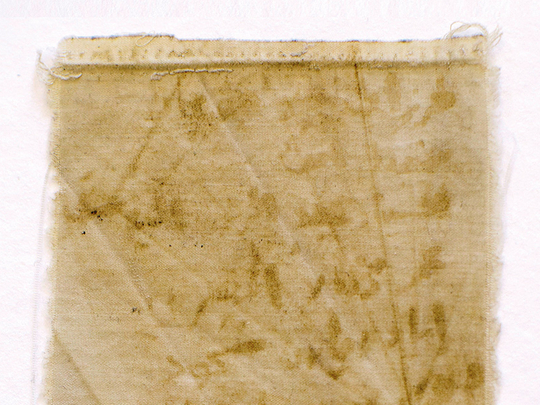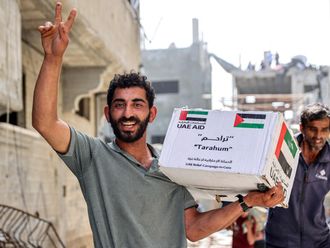
Mansour Omari| |
Bowie, Maryland: Under the clinical white lights of a Maryland conservation centre on Tuesday, Mansour Omari carefully laid out five scraps of worn material that had traveled within the collar of his shirt—past Syrian government forces and across oceans—covered in blood and rust, and in the fading names of the disappeared.
A human rights activist fighting for freedom of speech and chronicling the missing, Omari was arrested in February 2012 in his Damascus office and went on to spend about a year in a series of prisons, including nine months at a site under the supervision of Maher Al Assad, the brother of President Bashar Al Assad of Syria.
It was in that fetid underground jail that Omari and four of his fellow inmates set out to record the names of all 82 prisoners there, in the hope of informing their families and documenting the atrocities.
“When I was inside, I saw myself, what I was documenting,” he said.
“I saw it firsthand. I felt it was my duty, actually.”
The resulting lists, which included the prisoners’ contact details, were sewn into the collar and cuffs of a shirt and smuggled out by Omari, who was the first among the group to be released.
The scraps of material are now being lent to the US Holocaust Memorial Museum for an exhibition in Washington.
In that Syrian prison, with ruthless government guards watching over them, Omari and his friends had set about quietly improvising writing materials: Small panels of fabric were cut carefully from the backs of their shirts. Broken chicken bones were used as pens. And when the tomato sauce from their rations proved too thin for makeshift ink, the friends used blood from their ailing gums mixed with flakes of rust from the prison’s iron bars.
“We did it almost secretly,” Omari, 37, said, explaining how groups of cellmates formed close friendships in the prison.
“We didn’t want other people to know, because there is a danger that some of them would tell the general.”
He added, “We were going to some groups, sitting with them, asking for their names.”
Conservationists at the museum are preparing to study the fabric and are researching how best to preserve it.
The chief conservator, Jane E. Klinger, said her team was looking to construct containers to hold the documents - perhaps from plexiglass fitted with ultraviolet lights - which have so far been buried within a notebook Omari bought at the civilian prison to which he was moved in late 2012.
“That’s a very good solution for a lay person because they’re protected, flat, there’s an amount of cushioning,” Klinger said, using white gloves and small metal tools to look through Omari’s notebook.
About an hour’s drive from Washington on Tuesday at the museum’s David and Fela Shapell Family Collections, Conservation and Research Centre, Omari unveiled the names of the prisoners to a group of conservationists.
Flipping through the notebook’s worn pages, he revealed memories, all dated carefully on the top of every page.
Scribbled neatly on the book’s tattered front are the words “la dolce vita,” or “the good life.”
“I don’t take it out so much,” he said in slow, hushed English. “It’s so emotional for me when I see it.”
He added, “I was writing it for myself, trying to see that life is beautiful even after all that happened.”
Some pages are filled with Arabic, lessons in journalism and poetry that Omari taught an illiterate prisoner. There are also lines of basic English - “She knows her nose is big” - used to teach others.
“I convinced people,” he said.
“We are detained. We don’t know how long we will be there. But when you are released, if you have a language, that will help you.”
“You are in a place that you have all the time,” he said.
“You have nothing. You are doing nothing. You have nothing to do. So we had a lot of activities.”
Inmates sometimes created “televisions” by holding up a sheet and taking turns performing in front of it, he added.
Omari, who now lives in Sweden, estimates that 100,000 people have been held by government forces in Syria, where half the population is thought to have been displaced since the war began more than six years ago.
Scraps of documentation are slowly emerging, including letters from inmates and more names of missing people, as well as photographs smuggled out of the country by a Syrian police photographer that show widespread torture.
Omari was arrested for his contact with foreign entities, among other things.
And though the reasons for his release remain unclear, he said pressure from overseas probably helped.
Prison atrocities:
1) As many as 13,000 opponents of Bashar Al Assad were secretly hanged in one of Syria’s most infamous prisons in the first five years of the country’s civil war as part of an extermination policy ordered by the highest levels of the Syrian government, according to Amnesty International.
Many thousands more people held in Saydnaya prison died through torture and starvation, Amnesty said, and the bodies were dumped in two mass graves on the outskirts of Damascus between midnight and dawn most Tuesday mornings for at least five years.
2) Women have reportedly been hung from poles on prison ceilings, where they are subjected to horrific assaults over several days. According to the report by the London School of Economics, justification for the attacks can be as minor as having a picture of a revolutionary flag on their phone. The report claims violence is systematic under the Syrian regime, which has denied normalisation of rape and abuse as a method for interrogation and punishment for both men and women.
3) Children as young as four have been beaten and tortured. Although the Al Assad regime has rejected claims it is operating a Gulag system of jails in which tens of thousands have disappeared, been tortured and often never emerged again, more and more evidence is emerging to disprove those denials.
A woman who spoke to Sky News claims she saw men being tortured. “They would beat them and they wouldn’t have a chance to breathe, they would gasp or something like that, and it’s a really terrible sound,” she said.
“And we felt like those who were tortured for a while would lose their voice. And at first we didn’t know, but then we understood that whoever’s voice faded away or disappeared, that means he’s dead.”
The same woman claimed she saw children as young as four being beaten until their hands bled.











